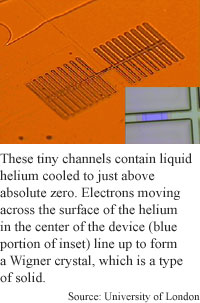
Cold
electrons crystallize
By
Kimberly Patch,
Technology Research NewsWhen electrons travel together in a current through electrical wire, they usually do so haphazardly, randomly bumping into each other as they push forward.
Researchers from the University of London and the University of Copenhagen have found a way to make electrons line up in a type of crystal as they travel.
The work promises to increase researchers' understanding of one of nature's most basic and useful particles, and is a step forward in using electrons to do extremely fast computations in quantum computers.
Electrons are one of the three basic particles that make up atoms. Between 1 and 117 electrons circle around an atom's nucleus depending on its type. Hydrogen, for example, holds onto just one electron, while copper has 29.
In a metal or semiconductor, the outermost electrons become detached from the atoms to form free electrons that can flow as electrical current through a wire.
The electrons the researchers worked with were flowing across the surface of superfluid liquid helium that was contained in tiny channels etched into a wafer of gallium arsenide.
Helium becomes a superfluid at about two degrees Kelvin, or -271 Celsius, and provides a smooth surface for the flowing electrons.
The channels formed a field-effect transistor, which controls electrical current.
Quantum particles like electrons have many weird properties. The electrons in the researchers' device are a type known as two-dimensional electrons because they can only move in the two-dimensional plane of the liquid's surface. The researchers controlled the electrons using positively charged metallic electrodes that attracted the negatively charged electrons.
In the researchers' device, the electrons behaved like normal free electrons at temperatures above one degree Kelvin. But below that the electrons packed together into offset rows similar to a single layer of ping-pong balls pushed together on the surface of a table.
These two-dimensional, solid arrays of electrons, or Wigner crystals, interacted with waves on the helium surface, said Michael Lea, a professor of physics at the University of London. As a Wigner crystal approached the speed of the waves it encountered increased resistance, "a bit like a sound barrier for airplanes," said Lea. This resistance is evidence that the electrons formed a type of solid.
Individual electrons that are part of a Wigner crystal could eventually be used as quantum bits, or qubits in a quantum computer, he said. "Such a computer would use localized electrons -- as in a crystal -- to perform calculations," said Lea.
The researchers are currently studying smaller numbers of electrons in similar structures that form single electron transistors, which need only one electron to switch on or off.
The work is an "experimental tour de force" that produced a new type of object, said Mark Dykman, a physics professor at Michigan State University. "Quite remarkably, the results demonstrate not only the onset of crystallization, but also that the wires can move past each other, [which shows that] ordered wires are well-defined objects," he said.
Understanding electrons better is essential in many facets of nanotechnology, said Dykman.
For example, one goal in miniaturizing computers is to make single-electron transistors. The Wigner wires demonstrate "what happens when several electrons are placed into confined space," he said, adding that the knowledge also has the potential to contribute to proposals that involve entirely new devices.
The effect has potential in quantum computing, said Dykman. "The work shows that... a small group of electrons can be controlled. This is certainly an important step," toward using those electrons for computing, he said.
It will take three to five years before proof-of-principle experiments determine whether the effect can be used for quantum computing, said Lea. Researchers generally agree that practical quantum computers will take a least 20 years to develop.
Lea's research colleagues were Philip Glasson, Vladimir Dotsenko, Parvis Fozooni, William Bailey and George Papageorgiou of the University of London, and Soeren Andresen and Anders Kristensen of the University of Copenhagen in Denmark.
They published the research in the October 22, 2001 issue of Physics Review Letters. The research was funded by the UK Engineering and Physical Sciences Research Council (EPSRC), the European Union (EU), the Royal Society and International Association for the promotion of cooperation with scientists from the New Independent States of the former Soviet Union (INTAS).
Timeline: 3-5 years, 20 years or more
Funding: Government
TRN Categories: Quantum Computing; Materials Science and Engineering
Story Type: News
Related Elements: Technical paper, "Wigner Wire: Electrons Act Orderly," Physical Review Letters, October 22, 2001.
Advertisements:
December 12, 2001
Page One
E-paper coming into view
Semiconductors control quantum spin
Cold electrons crystallize
Neat not always organized
Single molecule drives transistor

News:
Research News Roundup
Research Watch blog
Features:
View from the High Ground Q&A
How It Works
RSS Feeds:
News
Ad links:
Buy an ad link
| Advertisements:
|
 |
Ad links: Clear History
Buy an ad link
|
TRN
Newswire and Headline Feeds for Web sites
|
© Copyright Technology Research News, LLC 2000-2006. All rights reserved.